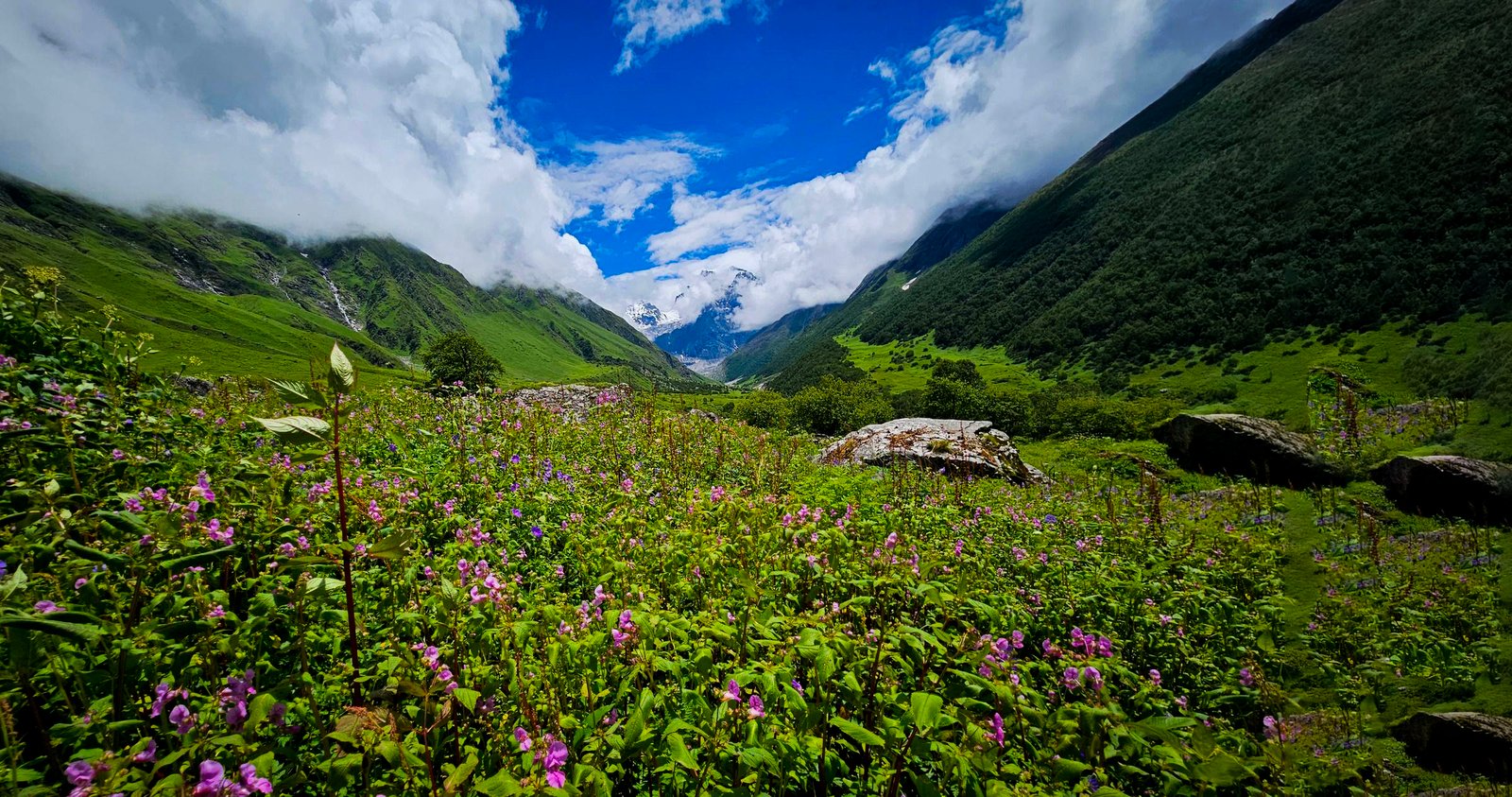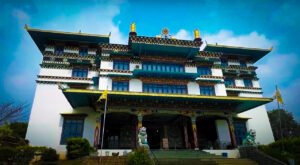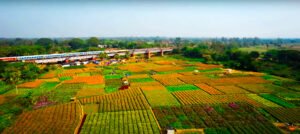Valley of Flowers in Uttarakhand is a hidden gem nestled in the Himalayas. The valley is incredibly beautiful, boasting a colorful carpet of flowers and diverse wildlife along a 15-kilometer trek from the main road waiting to enchant your senses.
The valley itself is a vast canvas, stretching as far as the eye can see. Just imagine hundreds of flower species in vibrant hues, creating a breathtaking sight. What makes it even more fascinating is that these flowers change every week! If you see a sea of pink and purple this week, next week the valley might transform into a tapestry of yellows and blues. It’s not just about flowers. You might spot some unique plants and animals too!

So, whether you’re a nature enthusiast or simply seeking a magical experience, put on your walking shoes, pack your sense of wonder, and embark on a journey to this floral paradise as this Valley of Flowers is an ever-evolving wonder waiting to be explored.
This region is part of the Nanda Devi Biosphere Reserve, which comprises two distinct parts: the Nanda Devi National Park and the renowned Valley of Flowers.
How to reach Valley of Flowers from Delhi:
The Valley of Flowers is open for just 4 to 5 months from June to early October. To reach this enchanting place, start from Rishikesh or the Dehradun Airport. Arriving from Delhi, consider taking an overnight bus or arranging a car rental at your convenience. Imagine waking up to the serene beauty of Rishikesh as you arrive—a perfect start to your journey. The trip from Delhi typically lasts around 8 hours, with bus fares ranging from 200 to 700 rupees and car rental costs varying between 4000 and 9000 rupees.
You have the convenience of securing your bus tickets through either the redBus app or the Abhi Bus app, perfect for seamless online reservations. For those looking to rent cars, the inDrive app is at your service. It’s worth mentioning, that the inDrive app, linked through my site, is an affiliate program that not only assists your booking but also supports my website.

Arrival at the Valley of Flowers: Day 1
After Rishikesh, the next leg of the journey takes you to Pipalkoti or Joshimath, roughly spanning a distance of 215 to 240 kilometers. You can travel by local bus or share a taxi to reach these destinations. It’s advisable to find accommodation upon reaching Pipalkoti or Joshimath, as it can get dark by then once you’ve rested overnight, set off in the morning for Govindghat, where you’ll find shared taxis and buses ready for your onward journey.

Worried about your luggage? No stress! Mules and porters are available for a reasonable fee of around 200 rupees. They make it easier to enjoy the journey, letting you soak in every bit of the valley’s breathtaking beauty.

The journey to the Valley of Flowers starts from Govindghat, a small and peaceful place situated 25 kilometers from Badrinath. Here, the Laxman Ganga River converges with the Alaknanda River. To begin your trek towards the valley, you’ll first head to Pulna Village from Govindghat. Accessible via a narrow 3-kilometer road or by sharing a taxi, Pulna marks the starting point of your actual trek towards Ghangaria. This is where your registration process begins if you plan to visit the Valley of Flowers or Hemkund Sahib. At Pulna, facilities such as parking, small homestays, and local food joints (dhabas) are available for travelers.
The trail from Pulna to Ghangaria spans 10 kilometers and begins with an uphill climb. It’s a challenging trek that tests your endurance, especially with its steep sections. About 2 kilometers into the trek from Pulna, the path gradually descends and leads through a marketplace known as Jungle Chatti. This is a good spot to take a breather and recharge yourself as several canteens and food joints are offering energy-boosting refreshments.
As a solo traveler, upon completing 2.5 kilometers of the trek, I discovered it to be even more challenging than my trek to Yamunotri.
(Read more about the Yamunotri trek)
You won’t have to buy water during the trek since there are many natural streams with the purest mountain water. The final 4 kilometers of the trek become tougher as it’s all uphill to Ghangaria. Because of the height, you might find yourself catching your breath more frequently.
If you begin your trek from Pulna Village around 7 am, you can typically reach Ghangaria by 11:30 am, taking about 4-5 hours. In Ghangaria, there are several hotels, food joints, and homestays available. Trekking to the Valley of Flowers from Ghangaria isn’t permitted in the afternoon due to the lengthy rocky path and concerns about wild animals. Ghangaria offers numerous small hotels and tents for accommodation.

Discover a curated list of accommodations for your consideration:
- Kuber Annex: Contact – 9412407006, 7579000833
- Ghangaria GNVM (Garhwal Mandal Vikas Nigam) – Deluxe rooms and dormitories available (slightly higher price, additional Rs 50 for hot water).
- Sri Nanda Lokpal Palace
- Hotel Priya
- Brahma kamal Camp
- Valley of Flowers Holiday Home
- Hotel Deepak Lodge
All these wonderful options, including a broader selection, can be booked through Tripadvisor. It’s worth mentioning, that Tripadvisor, linked through my site, is an affiliate program that not only assists your booking but also supports my website.
Arrival at the Valley of Flowers: Day 2
The next morning, your journey to the Valley of Flowers starts at 6:30 am from Ghangaria, nestled at a staggering 10,000 feet above sea level. As the Ghangaria market ends, two paths unravel a direct route to Hemkund Sahib and a leftward trail guiding you to the Valley of Flowers.
(Read more about Hemkund Sahib Trek)

While walking remains the primary mode, pony and porter services also offer assistance on this trek. Brace yourself; this adventure might just become one of your most awe-inspiring journeys. The path is rugged, scattered with sharp stones, adding to the thrill.
Around half a kilometer from Ghangaria, a checkpoint awaits where entry tickets for the Valley of Flowers are available. Indian nationals can secure a pass for Rs 150, while foreigners pay 600 INR. This checkpoint serves as the gateway, granting access after 7 am.

Beyond this checkpoint, the landscape broadens, revealing distant snow-capped peaks and the first signs of budding flowers. A water stream appears shortly after the checkpoint, quenching your thirst only until you reach the Valley itself. Remember to carry water from hereon.

The trail towards the Valley isn’t explicitly marked, offering intermittent paths, and injecting adventure into your journey. As you progress, the terrain occasionally flattens, unveiling captivating vistas, including the Bhyundar Village valley, a significant stop on your route to Ghangaria.
An important tip: start early to avoid the rain, typically around 11-12 o’clock.
Further along, the Pushpawati River crossing marks your proximity to the Valley—merely 3 kilometers away. Descending steps to a bridge, feeling the river’s cool splash eases the challenging paths ahead.
Crossing the bridge initiates a steep ascent for 2 kilometers, leading to a lush green forest housing ancient trees, aged over 200 years.

The final stretch is steeper, and tougher, with rugged rocks, but the cool, serene forest makes the journey delightful. As you traverse through stony trails and dense forests, watch out for landslide-prone areas, especially during rains.
The trail narrows, and flattens slightly, revealing the Valley’s colorful hues. A nearby stream and a wooden bridge signal your entry into this stunning floral paradise.
Finally, after a demanding 4-kilometer trek, you’re greeted by vibrant flowers, and lush meadows, surrounded by majestic mountains adorned with cascading waterfalls. Occasional veils of fog add to the Valley’s magical allure.

Let’s dive into some FAQs about the Valley of Flowers:
**Discovery and Significance: **
– In 1935, British mountaineer Frank Smith discovered the Valley of Flowers while returning from Mount Kamet.
– He camped for two days and named it the “Valley of Flowers.”
– Designated a National Park in 1982, grazing and settlements were prohibited.
**Valley Insights: **
– The valley houses over 500 plant species and various rare animals.
– Recognized as a World Heritage Site in 2005, it’s part of the Nanda Devi Biosphere Reserve.
– Served as an ancient trade route connecting Mana to Tibet.
**Valley Features: **
– The Pushpawati River divides the valley, originating from the Tipra Glacier.
– A memorial stands in honor of British botanist Lady Joan Margaret Legge, who had a fatal accident in 1939.
**Key Points: **
– Entry starts after 7 AM from Ghangharia.
– A Rs 150/person ticket at Ghangharia is required for access.
– No shops are available in the Valley, so carry food from Ghangharia.
– Mule services are available from Pulna to Ghangharia.
– Best visited between June and August, especially in August for various flowers.



Pingback: Divine Hemkund Sahib Trekking 2024 - India's Highest Gurudwara